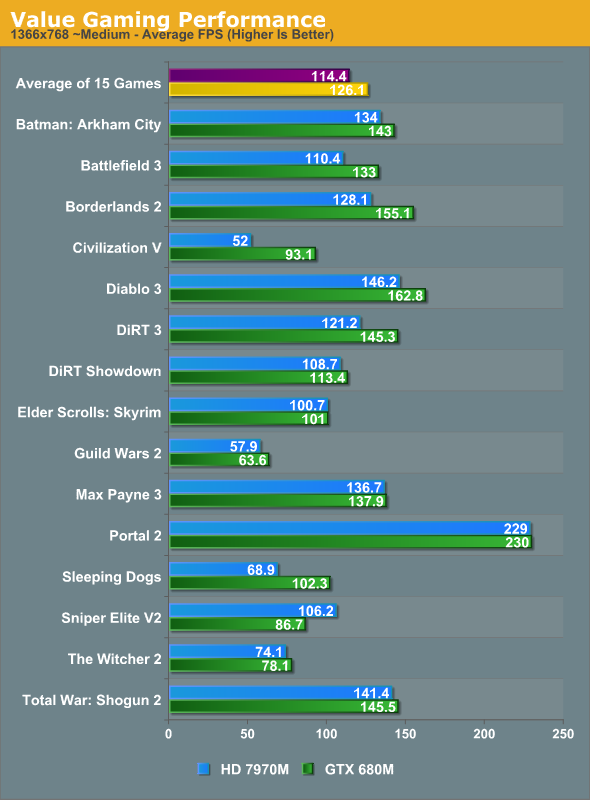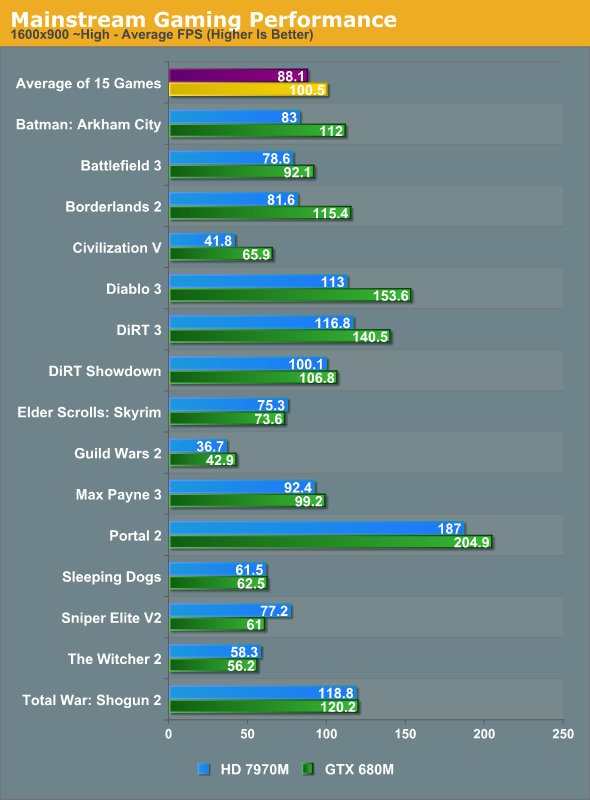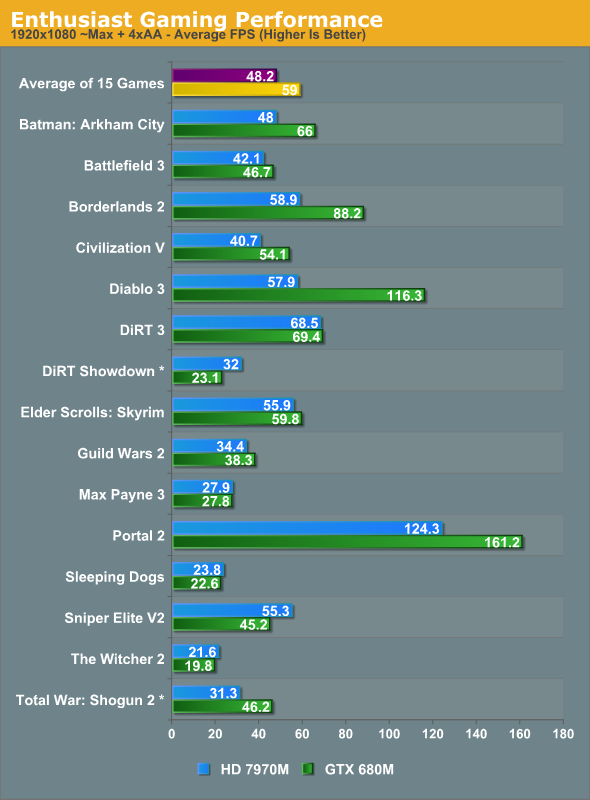AVADirect Clevo P170EM Part 2: GTX 680M Grudge Match
by Jarred Walton on October 15, 2012 6:50 PM ESTGTX 680M vs. HD 7970M – the Big Picture
Our 2012 gaming suite currently ranges in age from over two years old (Civ5) to as recent as 11 months old (Batman), with an average age of around 16 months. Hardware and games have both changed during that time, so we dug through our games folder and added a few other titles to the mix. Okay, truth be told, we actually have quite a few gaming codes from AMD and NVIDIA (as well as Guild Wars 2 from ArenaNet), and we figured a selection of games from both sides should be more or less “fair”. To that end, we’ve benchmarked eight additional games: Borderlands 2 (NVIDIA), Diablo 3 (“agnostic”), DiRT Showdown (AMD), Guild Wars 2 (“agnostic”), Max Payne 3 (NVIDIA), Sleeping Dogs (AMD), Sniper Elite V2 (AMD), and The Witcher 2 (NVIDIA). That’s three NVIDIA “TWIMTBP” (The Way It’s Meant To Be Played) games and three AMD “Gaming Evolved” titles, so overall things should be relatively even. Here’s how the two mobile GPUs stack up using the latest available drivers (NVIDIA 306.97 and an as-yet-unreleased 12.9 Hotfix from AMD), at all three of our target settings.

Not surprisingly, the two GPUs are closest in performance at our Value settings—the CPU becomes more of a bottleneck as we reduce the resolution and details. NVIDIA nearly sweeps the list of games, with Sniper Elite V2 being the sole game where AMD comes out ahead (by a relatively large 22% margin). By the numbers, NVIDIA has a 10% lead in Diablo 3 and Guild Wars 2; a 20% lead in Battlefield 3, Borderlands 2, and DiRT 3; a 50% lead in Sleeping Dogs; and an 80% lead in Civilization V. The remaining seven titles are around 5% or less margin of victory, so they’re basically tied. Overall, NVIDIA ends up with a 10% average performance lead over AMD.

When we move up to our Mainstream settings, the above pattern basically continues. NVIDIA’s overall advantage grows to 14%, with significant leads of 15% or more in Batman: Arkham City, Battlefield 3, Borderlands 2, Civilization V, Diablo 3, DiRT 3, and Guild Wars 2. AMD’s sole major lead continues to be Sniper Elite V2, though they also take a very slight lead in Skyrim and The Witcher 2. If we set the margin to beat at 15%, NVIDIA has seven wins, AMD gets one, and the remaining seven titles are “tied” (within 10%).

At our maximum detail settings, NVIDIA’s average margin of victory increases yet again, this time to 22%. Considering these are the settings most likely to be used with high-end gaming notebooks, the win here is the most meaningful. In terms of ties, there are seven games that are under the 15% margin (Battlefield 3, DiRT 3, Skyrim, Guild Wars 2, Max Payne 3, Sleeping Dogs, and The Witcher 2). Somewhat interesting however is that AMD now manages to come away with four moderate to major wins: DiRT Showdown is a 39% lead and Sniper Elite V2 is a 22% lead for AMD while Sleeping Dogs is a small 5% lead and The Witcher 2 is a 9% lead. The bad news for AMD is that of the remaining titles, NVIDIA comes away with resounding victories in many of them: 38% in Batman, 50% in Borderlands 2 (with the option to enable PhysX still available), 33% in Civilization V, 30% in Portal 2, 48% in Shogun 2, and a resounding 100% lead in Diablo 3.
At the end of the day, however, it’s not just about performance. In the desktop world of gaming PCs, we generally aim for 60FPS or higher as the level we want to reach in order for a game to run “smoothly”. On notebooks, we can’t be quite so demanding, so we have to settle for 30FPS in many cases. Out of our 15 games, at our Enthusiast settings we end up with several that don’t make it into the “playable” range: DiRT Showdown tanks when Global Lighting is enabled, but more so on NVIDIA than on AMD—the 7970M squeaks by with 32FPS while the 680M falls to an unplayable 23FPS. That’s the only title where we’d give one card a pass while the other falls short, but Max Payne 3, Sleeping Dogs, and The Witcher 2 are all too demanding to break 30FPS averages on either GPU. In most cases, dropping the detail settings down a notch (and/or disabling 4xAA—which basically cuts Max Payne 3 performance in half) will fix the problem, but if you were hoping a $2000 gaming notebook would simply take on all contenders without batting a shader core you’re going to be disappointed.
There are also a couple of issues with drivers to report, which we’ve marked with asterisks in the Enthusiast chart. DiRT Showdown refuses to run at 1920x1080 on the 7970M (with the Hotfix drivers), but it works in windowed mode—we tested the 680M in windowed mode as well and found that performance was about 15% lower than in full screen mode, but since this is a driver failure on AMD’s part what we used the higher result for the GTX 680M. (A quick test at 1680x1050 Ultra settings corroborates the margin of victory, regardless.) Second, Shogun 2 as noted earlier refuses to allow the Very High setting on the 7970M, so we tested both GPUs with identical “nearly maxed out” settings, where we used the “High” preset but then enabled all of the extras like Ambient Occlusion, Soft Shadows, etc. And a final note is that both DiRT Showdown and Sniper Elite V2 would crash to the desktop any time we tried to change the resolution within the game on the 7970M; we had to resort to modifying the configuration files directly to set the appropriate resolution.
Overall, NVIDIA clearly wins the performance crown, but we have to wonder how much of this is due to the hardware and how much might be coming from the drivers and developer relations. It’s not too surprising that AMD’s best results are in titles where they’ve apparently lent a hand (DiRT Showdown, Sniper Elite V2, and to a lesser degree Sleeping Dogs), and likewise NVIDIA gets some staggering leads in some of “their” titles. Also of note is that certain older games that were once AMD titles (e.g. Civilization V) now end up running better on NVIDIA GPUs. Is NVIDIA working with the developers after the fact, or optimizing their drivers, or perhaps a little of both? We can’t say for certain, but I do know that I’ve played a lot more games with NVIDIA logos during the boot sequence than games with AMD logos. Developer relations really are key, and titles like Borderlands 2 and Batman are popular offerings that shipped with PhysX support—yet another card in NVIDIA’s hand.










58 Comments
View All Comments
Harmattan - Wednesday, October 17, 2012 - link
I've now owned a p150hm with a 7970m, an m17x with a 7970m and 680m, an m18x with dual 7970m and another (my current) m18x with dual 680ms. After having spent many hours with each config, , my initial assertions stand...-if you're going single card and Clevo, get the 680m: although the drivers are almost comparable between the two cards, Enduro power management (and the inability to turn it off) is a whole heap of wrong.
-If you're going single card and AW, get the 7970m: since Enduro issues are not there, the price increase of the 680m is not justified.
-If you're going dual cards on either Clevo or AW, go 680m. 7970 CF drivers are a mess in many games and I experienced many issues (even after replaced cards)
All in all, I am happier and had less problems with the 680m on all configs. When the 7970m ran well, it is comparable, but that is rare.
The above points are just based on pure gaming performance at stock. If you're OC-ing, compare the desktop performance of a 7870 vs. GTX 670 - both cards are beasts, but the GTX 670 is +/-20% faster in most situations (and runs cooler).
TokamakH3 - Wednesday, October 17, 2012 - link
Would that fly in a desktop video card review? "Well, the Nvidia card is $574 while the AMD card is $300, but since the desktop you'll put it in will be $1975 vs $2249, there's only a 14% price difference, so we'll only look for a 14% performance difference"
That really makes no sense at all.
TokamakH3 - Wednesday, October 17, 2012 - link
Haha, dead horse. Should read before commenting, would delete the post if I could.cartmanasan - Thursday, October 18, 2012 - link
Don't know why no one covers professional applications like Maya, 3DSM etc. nVidia has got worse performance than their own previous cards. Have seen this going around in many forums. Gaming notebooks are well placed to be workstation/DTRs. No Mention of GPU Boost technology of nVidia as well. A comparison of overclocking would have been better too.transphasic - Saturday, October 20, 2012 - link
The reason AMD GPU's score far better than the Nvidia offerings this time around on business applications, is due to Nvidia's new Kepler-based designs are more gaming-oriented in it's focus, as opposed to the older Fermi-based chips, so that is the reason why, from what I have seen as an explanation from NBR.com for AMD to win this particular battle.Kepler-based GPU's are more for gaming performance, but the AMD fares better on business-related programs and applications.
tential - Monday, November 19, 2012 - link
I think I'm a little late to the party but the reviewers opinion in the Conclusion is just that. An OPINION. I usually skip to the conclusion pretty fast because I'd like to hear their opinion. The raw numbers is usually not enough to make a decision. If so, I'd had said "The 680M is faster but I think the 7970 is good enough for me." Now after reading further and factoring in driver support as well as the other issues with AMD, I think it'd be worthwhile to spend the extra money.I understand the gripe of using the GFX performance as the only thing that matters when considering the upgrade however but I don't think that's what the reviewer was doing. A laptop is used for many other things other than just gaming. Even a gaming laptop is. Hell, my gaming laptop is currently not even used for much gaming as I do a lot of other things on it. I think it's important for people to take the reviewers opinion in context though and to know that you have to make your own opinion. It's obvious that if you do a lot of other things other than gaming than maybe you can't justify the upgrade. However, if you primarily use it for gaming maybe you can. I think an update article in a couple of months would be nice though.
Also:
IMO, some things I'd like Anandtech to start including though would be an adjusted FPS page. This page would should FPS but would weight FPS above 60 lower. I really don't think there is a point in saying "Wow this card runs a game at 120 fps and this card runs it at 100 so the first card is what you should get!" Why not get the card that runs it at 100 fps when all I need is 60 FPS anyway right? I know this can be used to say that a card may run future games better but sometimes I'd like to know just about current games.
Hrel - Wednesday, January 2, 2013 - link
How did you measure GPU utilization? As far as I know FRAPS and the like only give FPS and admin tools don't have an option to add GPU to the list. So how did you do it? What did you use?Maybe it's in the article somewhere, but I'm at work and can't comb through the whole thing.
Hrel - Wednesday, January 2, 2013 - link
Every time you talk about what a hassel it is to carry around a laptop I imagine a little hobbit stuggling to pick up something (a large watermelon) just to have Argorn come and pick it up with one hand. It's such a none issue for me I would never even think to talk about it. Yet you go on like anything but an ultrabook just isn't portable. Lol. No point really, it just amuses me.My laptop bag is generally 30+ lbs and I never have any kind of issue carrying it around all day at a convention or airport or whatever. I'm curious if you're in the minority on this or I am. I mean, does it really matter if the thing weighs 6lbs or 11lbs? I can barely even tell the difference.